Eagle Airways: Strategic Analysis of London to Paris Route
VerifiedAdded on 2023/06/18
|12
|3098
|291
Report
AI Summary
This report provides a comprehensive analysis of Eagle Airways' strategy within the travel and tourism industry, with a specific focus on the London to Paris route. The report begins by discussing airline deregulation and its impact on the industry, followed by a Porter's Five Forces analysis of Eagle Airways, assessing the threats of substitutes, new entrants, buyer power, supplier power, and competitive rivalry. It identifies the airports at both ends of the route (London Stansted and Paris Beauvais), analyzes competitors such as Ryanair and Stansted Express, and examines the customer and market dynamics, highlighting the demand from youth and couples. Furthermore, the report explores future growth prospects and identifies potential barriers to entry, including fuel costs and supplier bargaining power. The overall aim is to provide a strategic overview of Eagle Airways' position and challenges in the competitive airline market.
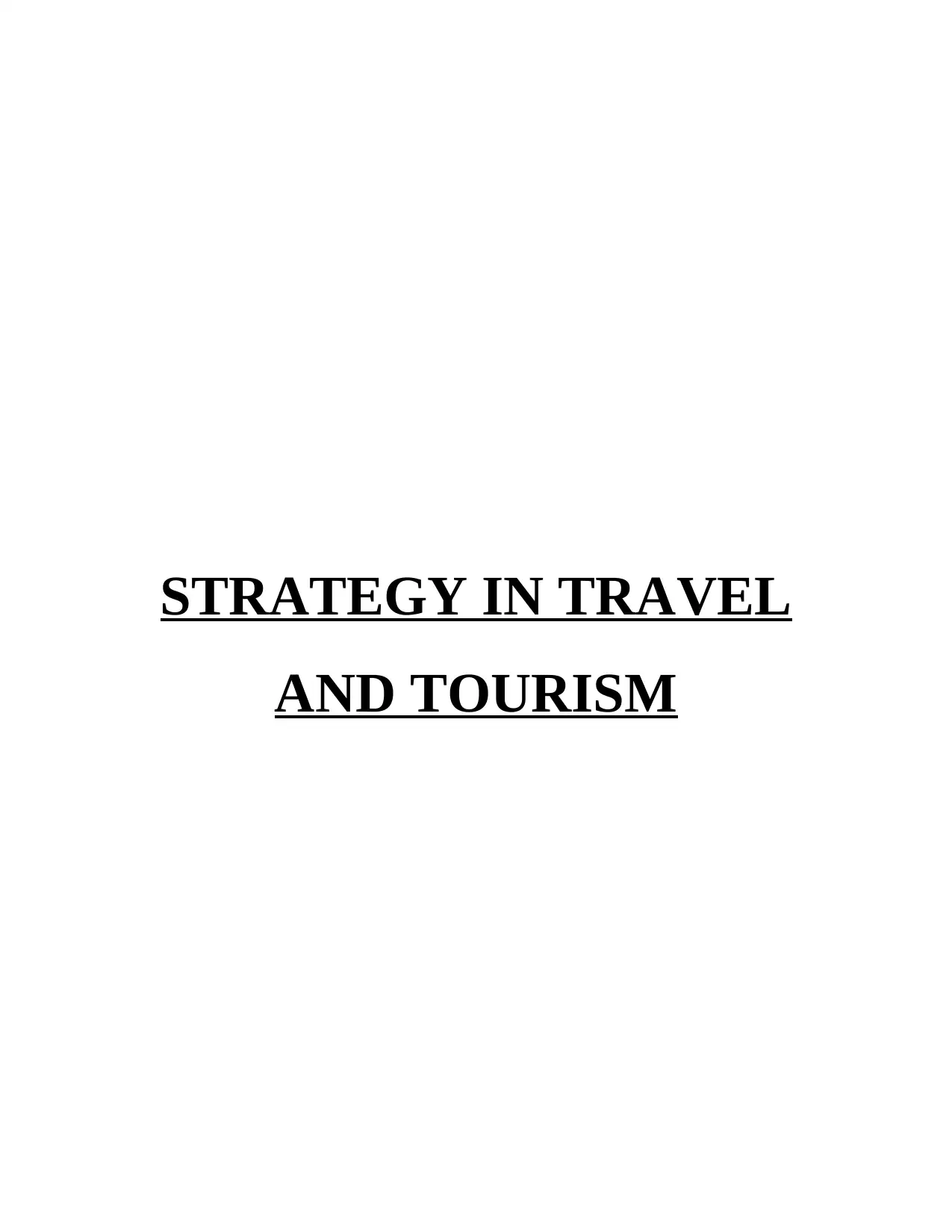
STRATEGY IN TRAVEL
AND TOURISM
AND TOURISM
Paraphrase This Document
Need a fresh take? Get an instant paraphrase of this document with our AI Paraphraser
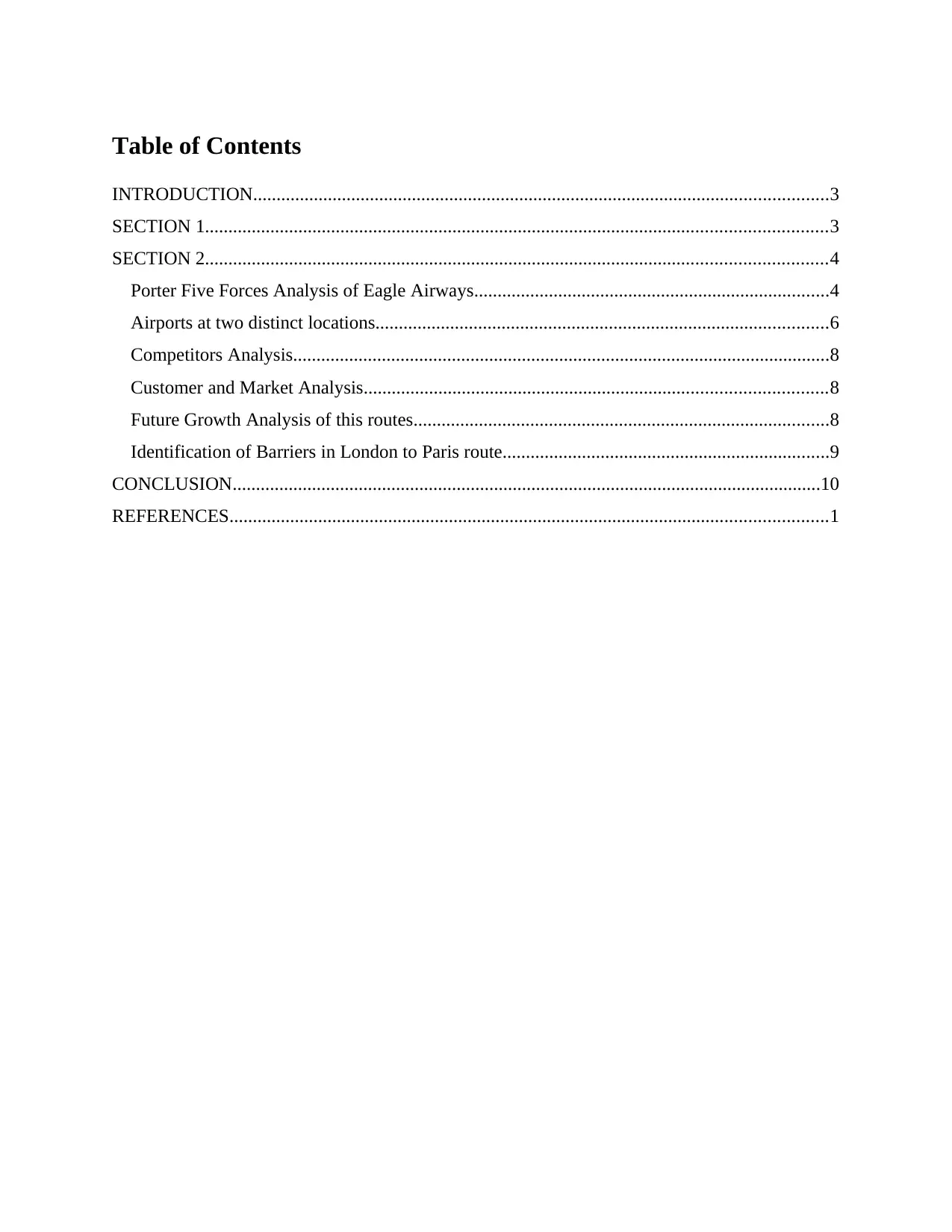
Table of Contents
INTRODUCTION...........................................................................................................................3
SECTION 1.....................................................................................................................................3
SECTION 2.....................................................................................................................................4
Porter Five Forces Analysis of Eagle Airways............................................................................4
Airports at two distinct locations.................................................................................................6
Competitors Analysis...................................................................................................................8
Customer and Market Analysis...................................................................................................8
Future Growth Analysis of this routes.........................................................................................8
Identification of Barriers in London to Paris route......................................................................9
CONCLUSION..............................................................................................................................10
REFERENCES................................................................................................................................1
INTRODUCTION...........................................................................................................................3
SECTION 1.....................................................................................................................................3
SECTION 2.....................................................................................................................................4
Porter Five Forces Analysis of Eagle Airways............................................................................4
Airports at two distinct locations.................................................................................................6
Competitors Analysis...................................................................................................................8
Customer and Market Analysis...................................................................................................8
Future Growth Analysis of this routes.........................................................................................8
Identification of Barriers in London to Paris route......................................................................9
CONCLUSION..............................................................................................................................10
REFERENCES................................................................................................................................1
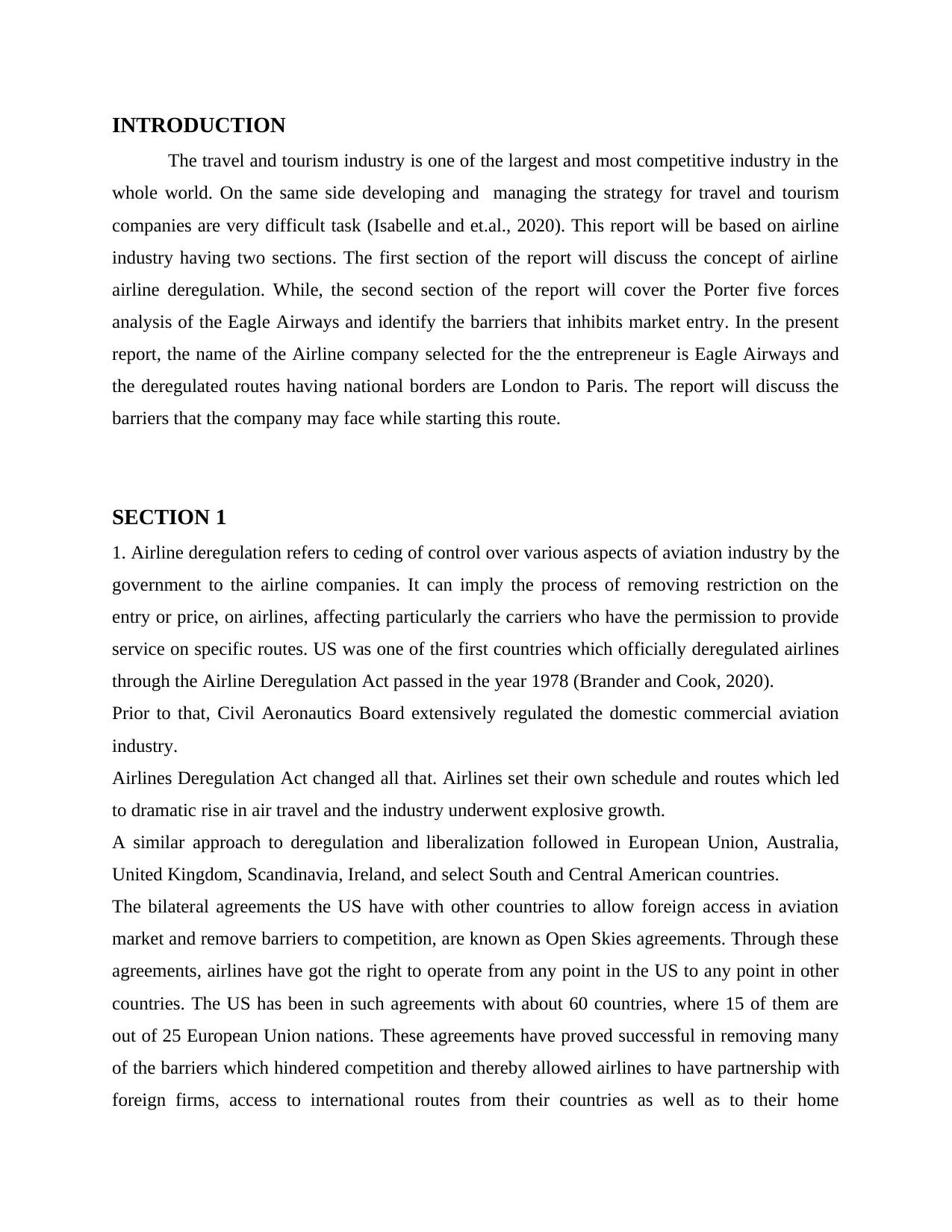
INTRODUCTION
The travel and tourism industry is one of the largest and most competitive industry in the
whole world. On the same side developing and managing the strategy for travel and tourism
companies are very difficult task (Isabelle and et.al., 2020). This report will be based on airline
industry having two sections. The first section of the report will discuss the concept of airline
airline deregulation. While, the second section of the report will cover the Porter five forces
analysis of the Eagle Airways and identify the barriers that inhibits market entry. In the present
report, the name of the Airline company selected for the the entrepreneur is Eagle Airways and
the deregulated routes having national borders are London to Paris. The report will discuss the
barriers that the company may face while starting this route.
SECTION 1
1. Airline deregulation refers to ceding of control over various aspects of aviation industry by the
government to the airline companies. It can imply the process of removing restriction on the
entry or price, on airlines, affecting particularly the carriers who have the permission to provide
service on specific routes. US was one of the first countries which officially deregulated airlines
through the Airline Deregulation Act passed in the year 1978 (Brander and Cook, 2020).
Prior to that, Civil Aeronautics Board extensively regulated the domestic commercial aviation
industry.
Airlines Deregulation Act changed all that. Airlines set their own schedule and routes which led
to dramatic rise in air travel and the industry underwent explosive growth.
A similar approach to deregulation and liberalization followed in European Union, Australia,
United Kingdom, Scandinavia, Ireland, and select South and Central American countries.
The bilateral agreements the US have with other countries to allow foreign access in aviation
market and remove barriers to competition, are known as Open Skies agreements. Through these
agreements, airlines have got the right to operate from any point in the US to any point in other
countries. The US has been in such agreements with about 60 countries, where 15 of them are
out of 25 European Union nations. These agreements have proved successful in removing many
of the barriers which hindered competition and thereby allowed airlines to have partnership with
foreign firms, access to international routes from their countries as well as to their home
The travel and tourism industry is one of the largest and most competitive industry in the
whole world. On the same side developing and managing the strategy for travel and tourism
companies are very difficult task (Isabelle and et.al., 2020). This report will be based on airline
industry having two sections. The first section of the report will discuss the concept of airline
airline deregulation. While, the second section of the report will cover the Porter five forces
analysis of the Eagle Airways and identify the barriers that inhibits market entry. In the present
report, the name of the Airline company selected for the the entrepreneur is Eagle Airways and
the deregulated routes having national borders are London to Paris. The report will discuss the
barriers that the company may face while starting this route.
SECTION 1
1. Airline deregulation refers to ceding of control over various aspects of aviation industry by the
government to the airline companies. It can imply the process of removing restriction on the
entry or price, on airlines, affecting particularly the carriers who have the permission to provide
service on specific routes. US was one of the first countries which officially deregulated airlines
through the Airline Deregulation Act passed in the year 1978 (Brander and Cook, 2020).
Prior to that, Civil Aeronautics Board extensively regulated the domestic commercial aviation
industry.
Airlines Deregulation Act changed all that. Airlines set their own schedule and routes which led
to dramatic rise in air travel and the industry underwent explosive growth.
A similar approach to deregulation and liberalization followed in European Union, Australia,
United Kingdom, Scandinavia, Ireland, and select South and Central American countries.
The bilateral agreements the US have with other countries to allow foreign access in aviation
market and remove barriers to competition, are known as Open Skies agreements. Through these
agreements, airlines have got the right to operate from any point in the US to any point in other
countries. The US has been in such agreements with about 60 countries, where 15 of them are
out of 25 European Union nations. These agreements have proved successful in removing many
of the barriers which hindered competition and thereby allowed airlines to have partnership with
foreign firms, access to international routes from their countries as well as to their home
⊘ This is a preview!⊘
Do you want full access?
Subscribe today to unlock all pages.

Trusted by 1+ million students worldwide
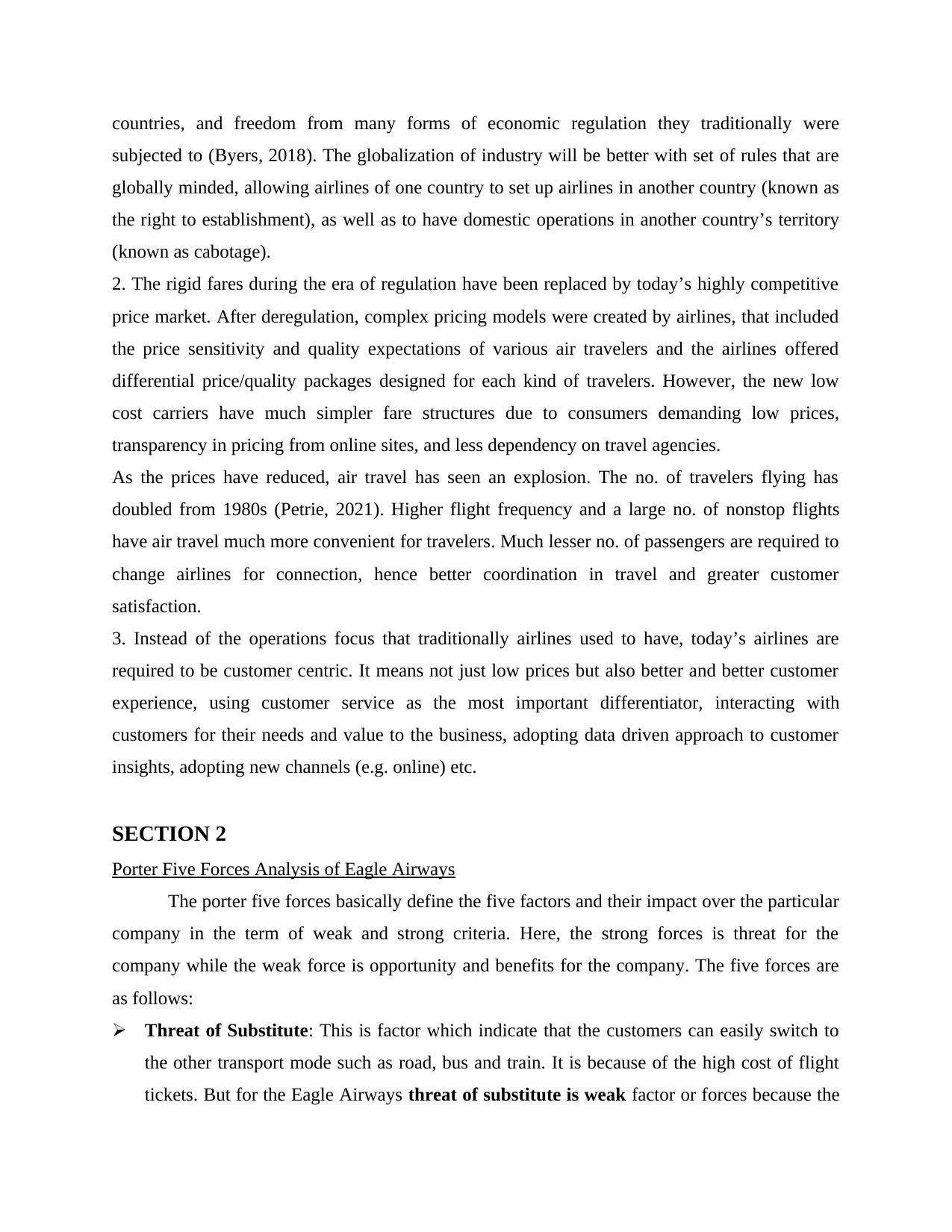
countries, and freedom from many forms of economic regulation they traditionally were
subjected to (Byers, 2018). The globalization of industry will be better with set of rules that are
globally minded, allowing airlines of one country to set up airlines in another country (known as
the right to establishment), as well as to have domestic operations in another country’s territory
(known as cabotage).
2. The rigid fares during the era of regulation have been replaced by today’s highly competitive
price market. After deregulation, complex pricing models were created by airlines, that included
the price sensitivity and quality expectations of various air travelers and the airlines offered
differential price/quality packages designed for each kind of travelers. However, the new low
cost carriers have much simpler fare structures due to consumers demanding low prices,
transparency in pricing from online sites, and less dependency on travel agencies.
As the prices have reduced, air travel has seen an explosion. The no. of travelers flying has
doubled from 1980s (Petrie, 2021). Higher flight frequency and a large no. of nonstop flights
have air travel much more convenient for travelers. Much lesser no. of passengers are required to
change airlines for connection, hence better coordination in travel and greater customer
satisfaction.
3. Instead of the operations focus that traditionally airlines used to have, today’s airlines are
required to be customer centric. It means not just low prices but also better and better customer
experience, using customer service as the most important differentiator, interacting with
customers for their needs and value to the business, adopting data driven approach to customer
insights, adopting new channels (e.g. online) etc.
SECTION 2
Porter Five Forces Analysis of Eagle Airways
The porter five forces basically define the five factors and their impact over the particular
company in the term of weak and strong criteria. Here, the strong forces is threat for the
company while the weak force is opportunity and benefits for the company. The five forces are
as follows:
Threat of Substitute: This is factor which indicate that the customers can easily switch to
the other transport mode such as road, bus and train. It is because of the high cost of flight
tickets. But for the Eagle Airways threat of substitute is weak factor or forces because the
subjected to (Byers, 2018). The globalization of industry will be better with set of rules that are
globally minded, allowing airlines of one country to set up airlines in another country (known as
the right to establishment), as well as to have domestic operations in another country’s territory
(known as cabotage).
2. The rigid fares during the era of regulation have been replaced by today’s highly competitive
price market. After deregulation, complex pricing models were created by airlines, that included
the price sensitivity and quality expectations of various air travelers and the airlines offered
differential price/quality packages designed for each kind of travelers. However, the new low
cost carriers have much simpler fare structures due to consumers demanding low prices,
transparency in pricing from online sites, and less dependency on travel agencies.
As the prices have reduced, air travel has seen an explosion. The no. of travelers flying has
doubled from 1980s (Petrie, 2021). Higher flight frequency and a large no. of nonstop flights
have air travel much more convenient for travelers. Much lesser no. of passengers are required to
change airlines for connection, hence better coordination in travel and greater customer
satisfaction.
3. Instead of the operations focus that traditionally airlines used to have, today’s airlines are
required to be customer centric. It means not just low prices but also better and better customer
experience, using customer service as the most important differentiator, interacting with
customers for their needs and value to the business, adopting data driven approach to customer
insights, adopting new channels (e.g. online) etc.
SECTION 2
Porter Five Forces Analysis of Eagle Airways
The porter five forces basically define the five factors and their impact over the particular
company in the term of weak and strong criteria. Here, the strong forces is threat for the
company while the weak force is opportunity and benefits for the company. The five forces are
as follows:
Threat of Substitute: This is factor which indicate that the customers can easily switch to
the other transport mode such as road, bus and train. It is because of the high cost of flight
tickets. But for the Eagle Airways threat of substitute is weak factor or forces because the
Paraphrase This Document
Need a fresh take? Get an instant paraphrase of this document with our AI Paraphraser
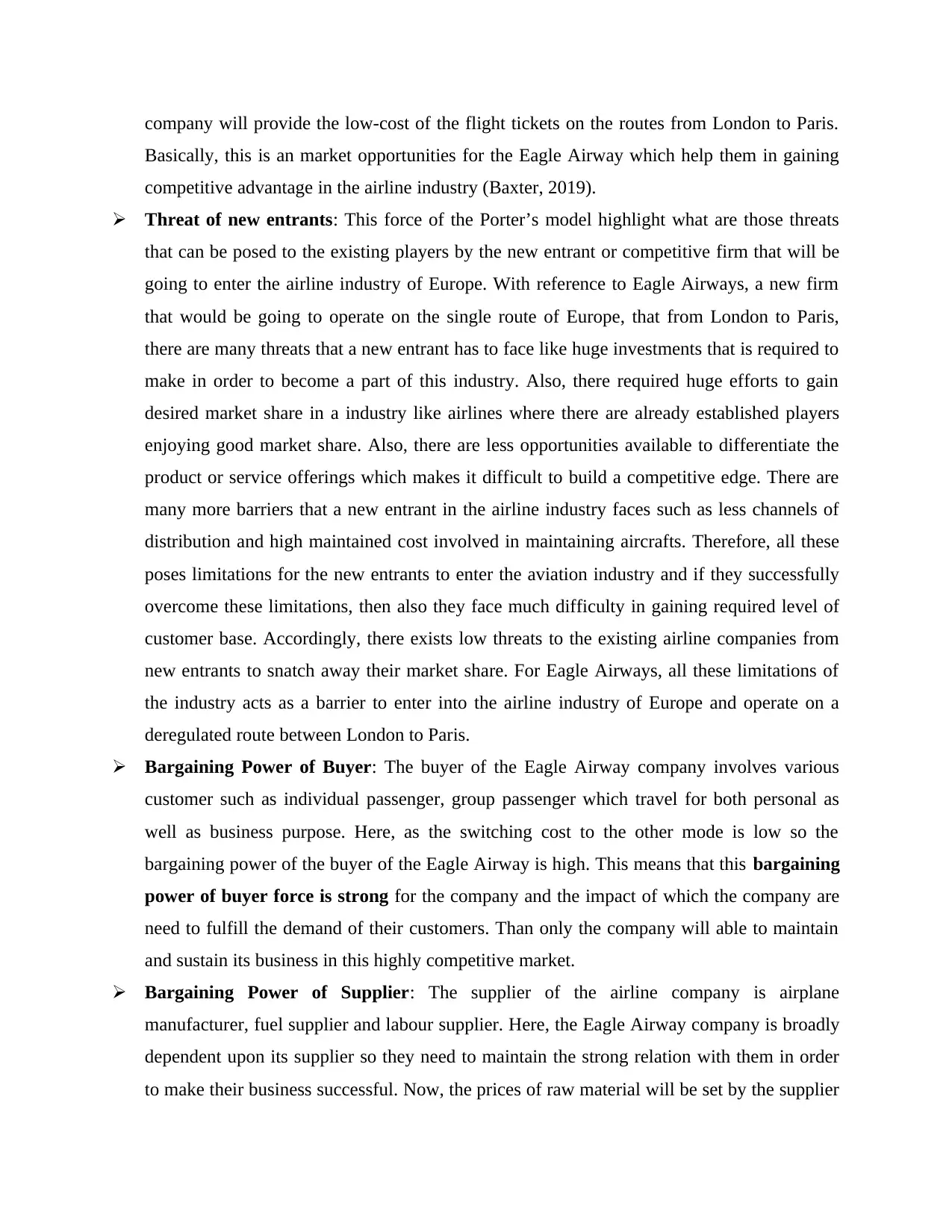
company will provide the low-cost of the flight tickets on the routes from London to Paris.
Basically, this is an market opportunities for the Eagle Airway which help them in gaining
competitive advantage in the airline industry (Baxter, 2019).
Threat of new entrants: This force of the Porter’s model highlight what are those threats
that can be posed to the existing players by the new entrant or competitive firm that will be
going to enter the airline industry of Europe. With reference to Eagle Airways, a new firm
that would be going to operate on the single route of Europe, that from London to Paris,
there are many threats that a new entrant has to face like huge investments that is required to
make in order to become a part of this industry. Also, there required huge efforts to gain
desired market share in a industry like airlines where there are already established players
enjoying good market share. Also, there are less opportunities available to differentiate the
product or service offerings which makes it difficult to build a competitive edge. There are
many more barriers that a new entrant in the airline industry faces such as less channels of
distribution and high maintained cost involved in maintaining aircrafts. Therefore, all these
poses limitations for the new entrants to enter the aviation industry and if they successfully
overcome these limitations, then also they face much difficulty in gaining required level of
customer base. Accordingly, there exists low threats to the existing airline companies from
new entrants to snatch away their market share. For Eagle Airways, all these limitations of
the industry acts as a barrier to enter into the airline industry of Europe and operate on a
deregulated route between London to Paris.
Bargaining Power of Buyer: The buyer of the Eagle Airway company involves various
customer such as individual passenger, group passenger which travel for both personal as
well as business purpose. Here, as the switching cost to the other mode is low so the
bargaining power of the buyer of the Eagle Airway is high. This means that this bargaining
power of buyer force is strong for the company and the impact of which the company are
need to fulfill the demand of their customers. Than only the company will able to maintain
and sustain its business in this highly competitive market.
Bargaining Power of Supplier: The supplier of the airline company is airplane
manufacturer, fuel supplier and labour supplier. Here, the Eagle Airway company is broadly
dependent upon its supplier so they need to maintain the strong relation with them in order
to make their business successful. Now, the prices of raw material will be set by the supplier
Basically, this is an market opportunities for the Eagle Airway which help them in gaining
competitive advantage in the airline industry (Baxter, 2019).
Threat of new entrants: This force of the Porter’s model highlight what are those threats
that can be posed to the existing players by the new entrant or competitive firm that will be
going to enter the airline industry of Europe. With reference to Eagle Airways, a new firm
that would be going to operate on the single route of Europe, that from London to Paris,
there are many threats that a new entrant has to face like huge investments that is required to
make in order to become a part of this industry. Also, there required huge efforts to gain
desired market share in a industry like airlines where there are already established players
enjoying good market share. Also, there are less opportunities available to differentiate the
product or service offerings which makes it difficult to build a competitive edge. There are
many more barriers that a new entrant in the airline industry faces such as less channels of
distribution and high maintained cost involved in maintaining aircrafts. Therefore, all these
poses limitations for the new entrants to enter the aviation industry and if they successfully
overcome these limitations, then also they face much difficulty in gaining required level of
customer base. Accordingly, there exists low threats to the existing airline companies from
new entrants to snatch away their market share. For Eagle Airways, all these limitations of
the industry acts as a barrier to enter into the airline industry of Europe and operate on a
deregulated route between London to Paris.
Bargaining Power of Buyer: The buyer of the Eagle Airway company involves various
customer such as individual passenger, group passenger which travel for both personal as
well as business purpose. Here, as the switching cost to the other mode is low so the
bargaining power of the buyer of the Eagle Airway is high. This means that this bargaining
power of buyer force is strong for the company and the impact of which the company are
need to fulfill the demand of their customers. Than only the company will able to maintain
and sustain its business in this highly competitive market.
Bargaining Power of Supplier: The supplier of the airline company is airplane
manufacturer, fuel supplier and labour supplier. Here, the Eagle Airway company is broadly
dependent upon its supplier so they need to maintain the strong relation with them in order
to make their business successful. Now, the prices of raw material will be set by the supplier
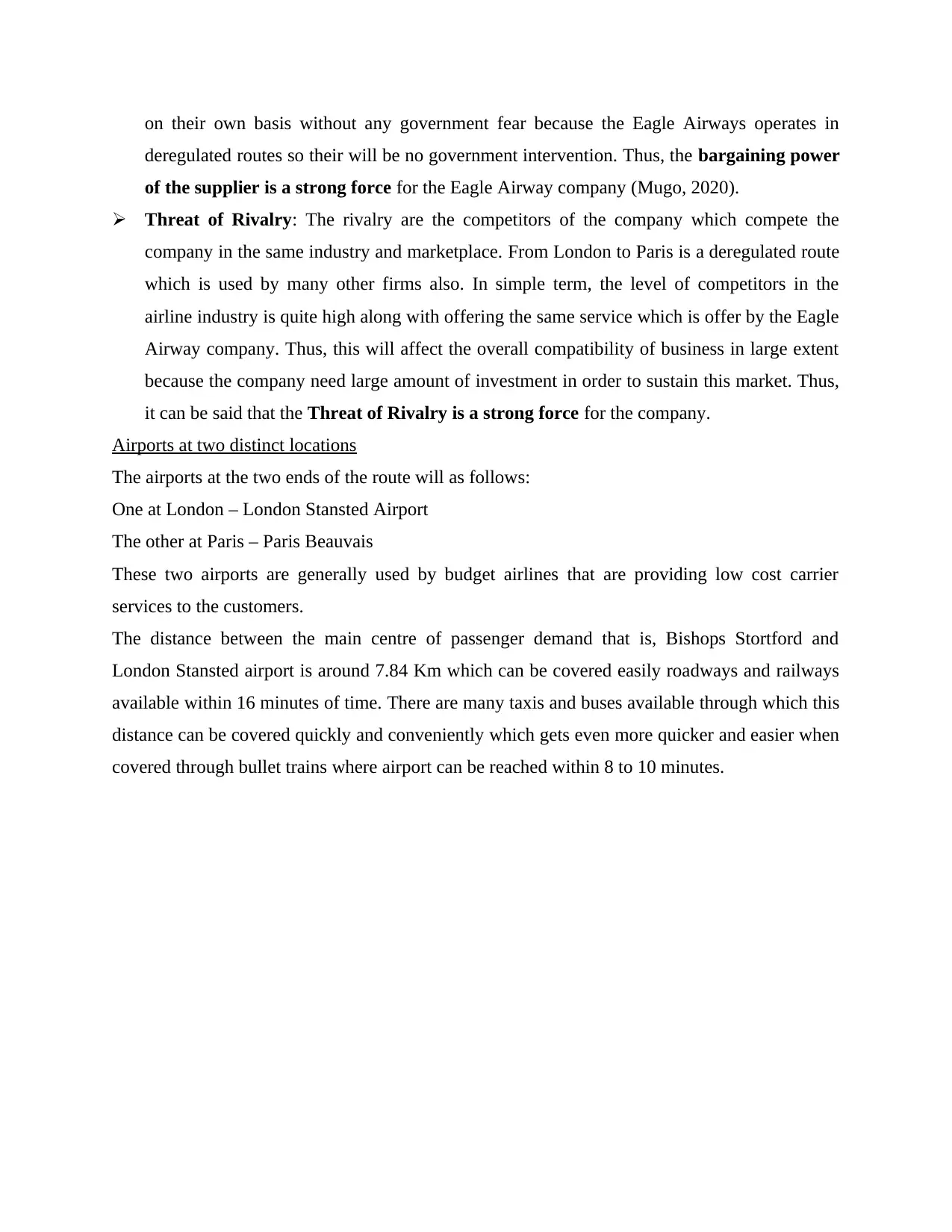
on their own basis without any government fear because the Eagle Airways operates in
deregulated routes so their will be no government intervention. Thus, the bargaining power
of the supplier is a strong force for the Eagle Airway company (Mugo, 2020).
Threat of Rivalry: The rivalry are the competitors of the company which compete the
company in the same industry and marketplace. From London to Paris is a deregulated route
which is used by many other firms also. In simple term, the level of competitors in the
airline industry is quite high along with offering the same service which is offer by the Eagle
Airway company. Thus, this will affect the overall compatibility of business in large extent
because the company need large amount of investment in order to sustain this market. Thus,
it can be said that the Threat of Rivalry is a strong force for the company.
Airports at two distinct locations
The airports at the two ends of the route will as follows:
One at London – London Stansted Airport
The other at Paris – Paris Beauvais
These two airports are generally used by budget airlines that are providing low cost carrier
services to the customers.
The distance between the main centre of passenger demand that is, Bishops Stortford and
London Stansted airport is around 7.84 Km which can be covered easily roadways and railways
available within 16 minutes of time. There are many taxis and buses available through which this
distance can be covered quickly and conveniently which gets even more quicker and easier when
covered through bullet trains where airport can be reached within 8 to 10 minutes.
deregulated routes so their will be no government intervention. Thus, the bargaining power
of the supplier is a strong force for the Eagle Airway company (Mugo, 2020).
Threat of Rivalry: The rivalry are the competitors of the company which compete the
company in the same industry and marketplace. From London to Paris is a deregulated route
which is used by many other firms also. In simple term, the level of competitors in the
airline industry is quite high along with offering the same service which is offer by the Eagle
Airway company. Thus, this will affect the overall compatibility of business in large extent
because the company need large amount of investment in order to sustain this market. Thus,
it can be said that the Threat of Rivalry is a strong force for the company.
Airports at two distinct locations
The airports at the two ends of the route will as follows:
One at London – London Stansted Airport
The other at Paris – Paris Beauvais
These two airports are generally used by budget airlines that are providing low cost carrier
services to the customers.
The distance between the main centre of passenger demand that is, Bishops Stortford and
London Stansted airport is around 7.84 Km which can be covered easily roadways and railways
available within 16 minutes of time. There are many taxis and buses available through which this
distance can be covered quickly and conveniently which gets even more quicker and easier when
covered through bullet trains where airport can be reached within 8 to 10 minutes.
⊘ This is a preview!⊘
Do you want full access?
Subscribe today to unlock all pages.

Trusted by 1+ million students worldwide
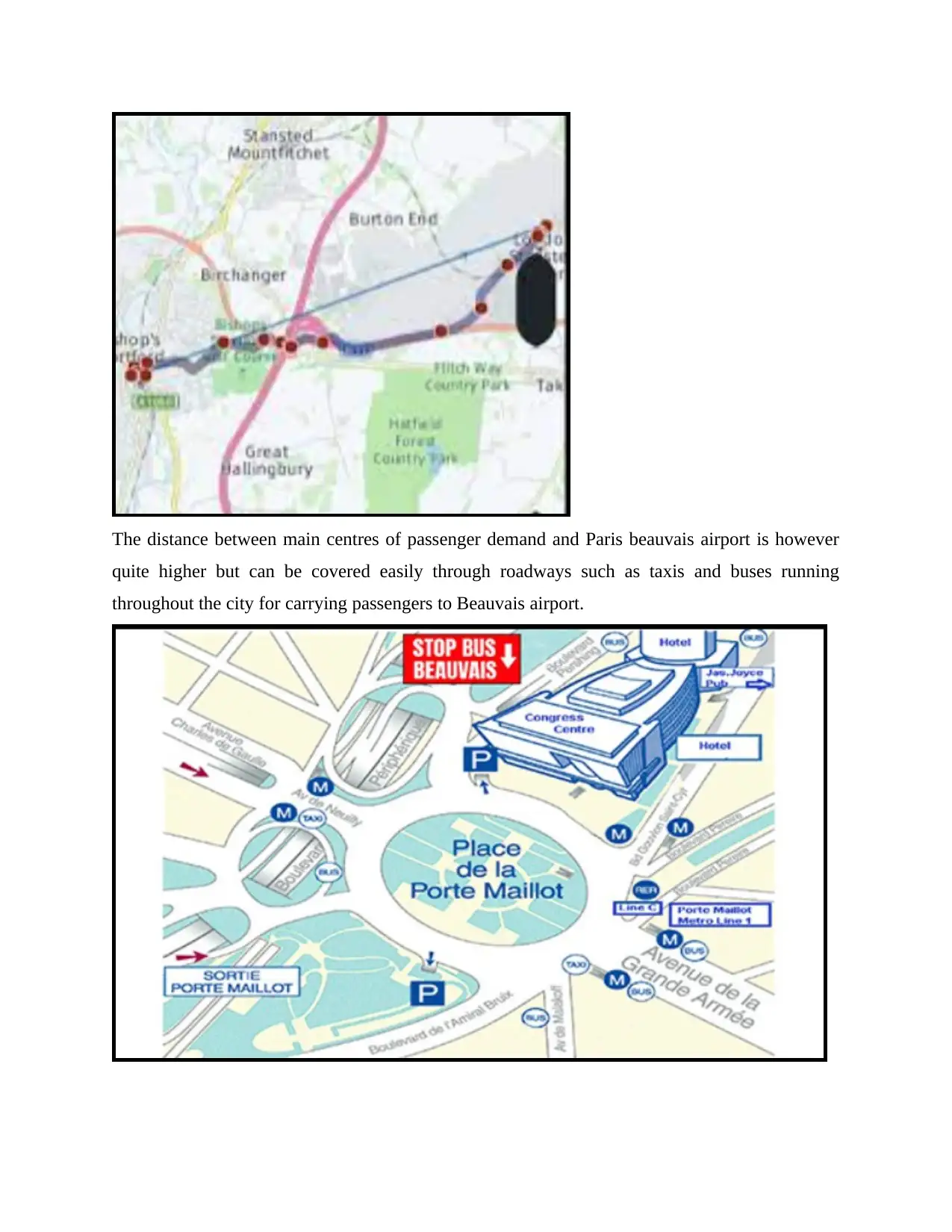
The distance between main centres of passenger demand and Paris beauvais airport is however
quite higher but can be covered easily through roadways such as taxis and buses running
throughout the city for carrying passengers to Beauvais airport.
quite higher but can be covered easily through roadways such as taxis and buses running
throughout the city for carrying passengers to Beauvais airport.
Paraphrase This Document
Need a fresh take? Get an instant paraphrase of this document with our AI Paraphraser
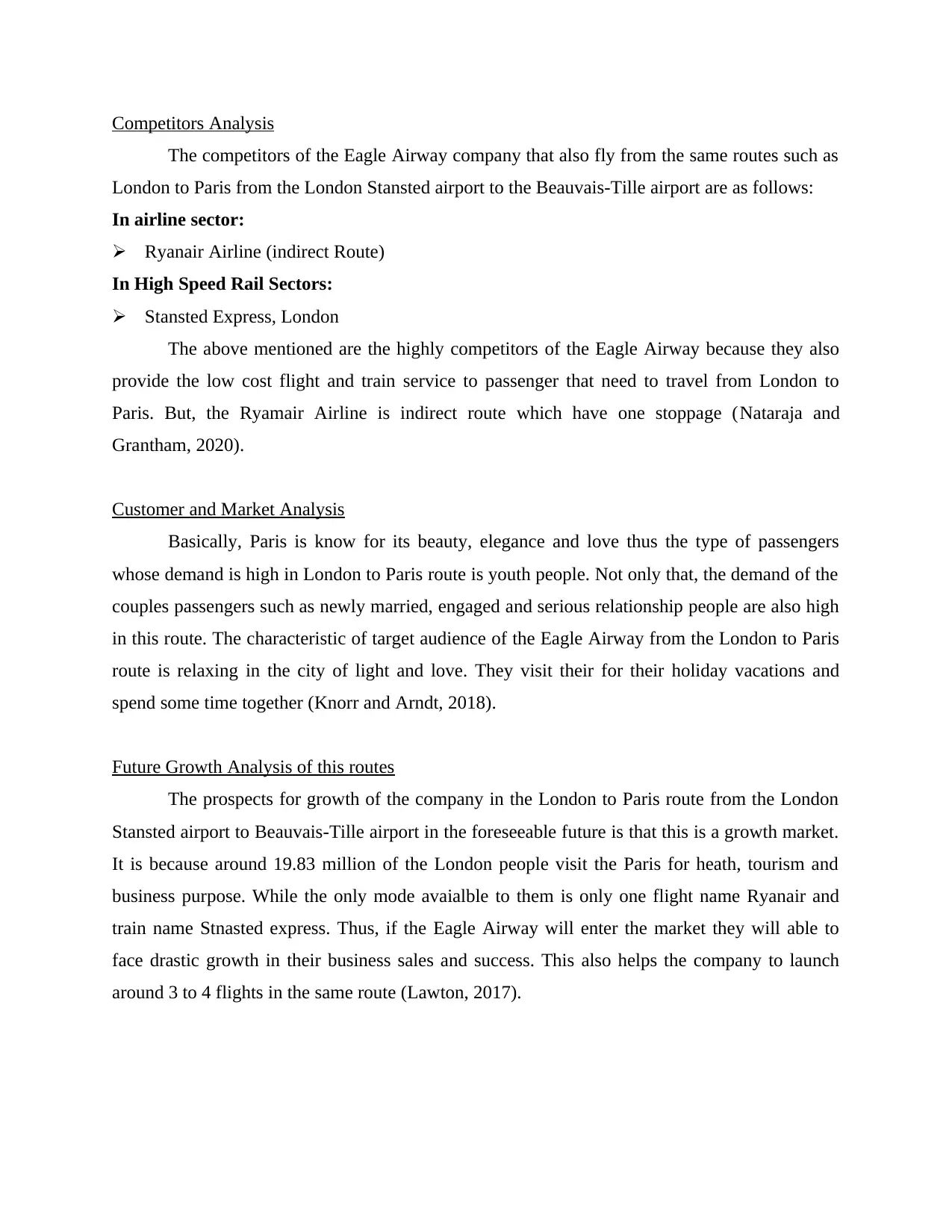
Competitors Analysis
The competitors of the Eagle Airway company that also fly from the same routes such as
London to Paris from the London Stansted airport to the Beauvais-Tille airport are as follows:
In airline sector:
Ryanair Airline (indirect Route)
In High Speed Rail Sectors:
Stansted Express, London
The above mentioned are the highly competitors of the Eagle Airway because they also
provide the low cost flight and train service to passenger that need to travel from London to
Paris. But, the Ryamair Airline is indirect route which have one stoppage (Nataraja and
Grantham, 2020).
Customer and Market Analysis
Basically, Paris is know for its beauty, elegance and love thus the type of passengers
whose demand is high in London to Paris route is youth people. Not only that, the demand of the
couples passengers such as newly married, engaged and serious relationship people are also high
in this route. The characteristic of target audience of the Eagle Airway from the London to Paris
route is relaxing in the city of light and love. They visit their for their holiday vacations and
spend some time together (Knorr and Arndt, 2018).
Future Growth Analysis of this routes
The prospects for growth of the company in the London to Paris route from the London
Stansted airport to Beauvais-Tille airport in the foreseeable future is that this is a growth market.
It is because around 19.83 million of the London people visit the Paris for heath, tourism and
business purpose. While the only mode avaialble to them is only one flight name Ryanair and
train name Stnasted express. Thus, if the Eagle Airway will enter the market they will able to
face drastic growth in their business sales and success. This also helps the company to launch
around 3 to 4 flights in the same route (Lawton, 2017).
The competitors of the Eagle Airway company that also fly from the same routes such as
London to Paris from the London Stansted airport to the Beauvais-Tille airport are as follows:
In airline sector:
Ryanair Airline (indirect Route)
In High Speed Rail Sectors:
Stansted Express, London
The above mentioned are the highly competitors of the Eagle Airway because they also
provide the low cost flight and train service to passenger that need to travel from London to
Paris. But, the Ryamair Airline is indirect route which have one stoppage (Nataraja and
Grantham, 2020).
Customer and Market Analysis
Basically, Paris is know for its beauty, elegance and love thus the type of passengers
whose demand is high in London to Paris route is youth people. Not only that, the demand of the
couples passengers such as newly married, engaged and serious relationship people are also high
in this route. The characteristic of target audience of the Eagle Airway from the London to Paris
route is relaxing in the city of light and love. They visit their for their holiday vacations and
spend some time together (Knorr and Arndt, 2018).
Future Growth Analysis of this routes
The prospects for growth of the company in the London to Paris route from the London
Stansted airport to Beauvais-Tille airport in the foreseeable future is that this is a growth market.
It is because around 19.83 million of the London people visit the Paris for heath, tourism and
business purpose. While the only mode avaialble to them is only one flight name Ryanair and
train name Stnasted express. Thus, if the Eagle Airway will enter the market they will able to
face drastic growth in their business sales and success. This also helps the company to launch
around 3 to 4 flights in the same route (Lawton, 2017).
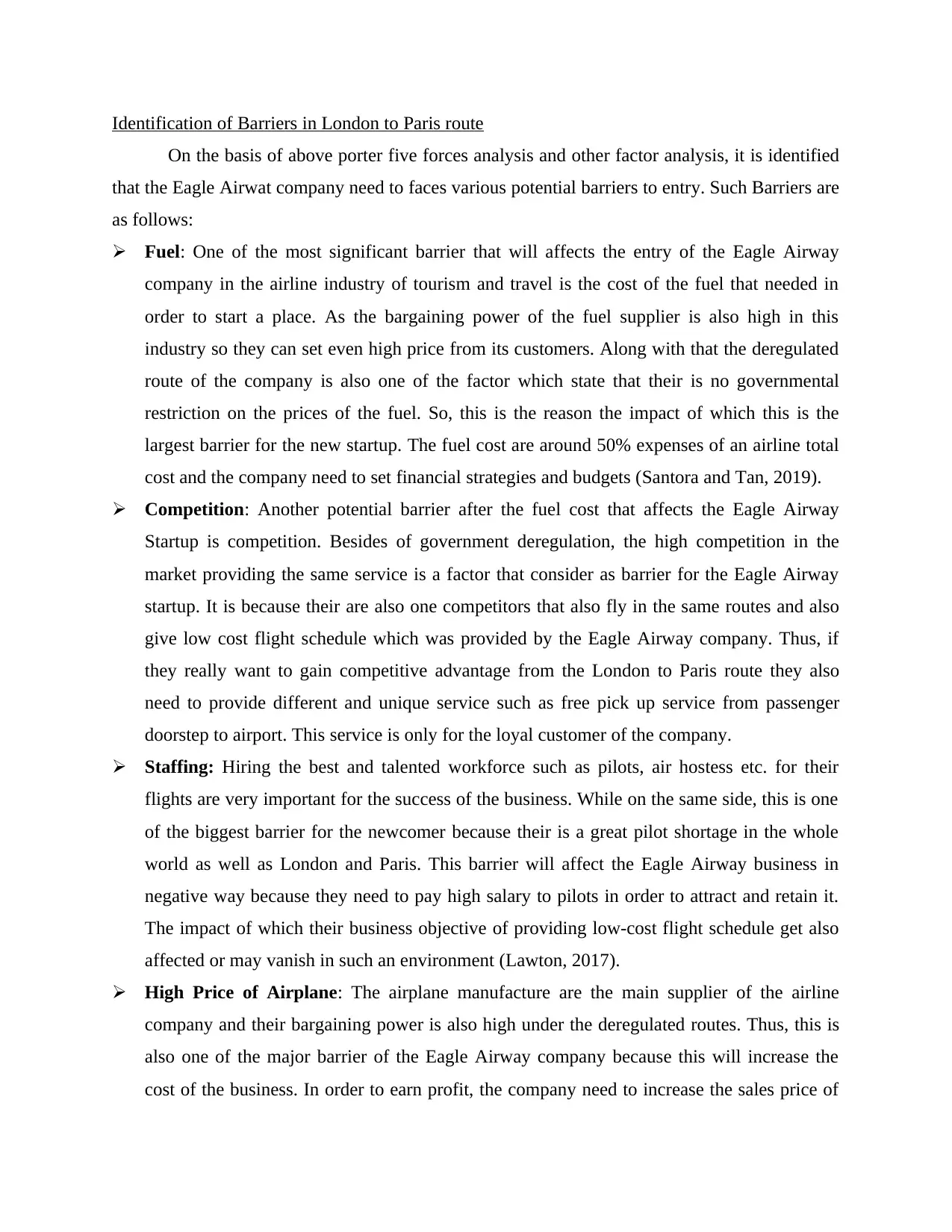
Identification of Barriers in London to Paris route
On the basis of above porter five forces analysis and other factor analysis, it is identified
that the Eagle Airwat company need to faces various potential barriers to entry. Such Barriers are
as follows:
Fuel: One of the most significant barrier that will affects the entry of the Eagle Airway
company in the airline industry of tourism and travel is the cost of the fuel that needed in
order to start a place. As the bargaining power of the fuel supplier is also high in this
industry so they can set even high price from its customers. Along with that the deregulated
route of the company is also one of the factor which state that their is no governmental
restriction on the prices of the fuel. So, this is the reason the impact of which this is the
largest barrier for the new startup. The fuel cost are around 50% expenses of an airline total
cost and the company need to set financial strategies and budgets (Santora and Tan, 2019).
Competition: Another potential barrier after the fuel cost that affects the Eagle Airway
Startup is competition. Besides of government deregulation, the high competition in the
market providing the same service is a factor that consider as barrier for the Eagle Airway
startup. It is because their are also one competitors that also fly in the same routes and also
give low cost flight schedule which was provided by the Eagle Airway company. Thus, if
they really want to gain competitive advantage from the London to Paris route they also
need to provide different and unique service such as free pick up service from passenger
doorstep to airport. This service is only for the loyal customer of the company.
Staffing: Hiring the best and talented workforce such as pilots, air hostess etc. for their
flights are very important for the success of the business. While on the same side, this is one
of the biggest barrier for the newcomer because their is a great pilot shortage in the whole
world as well as London and Paris. This barrier will affect the Eagle Airway business in
negative way because they need to pay high salary to pilots in order to attract and retain it.
The impact of which their business objective of providing low-cost flight schedule get also
affected or may vanish in such an environment (Lawton, 2017).
High Price of Airplane: The airplane manufacture are the main supplier of the airline
company and their bargaining power is also high under the deregulated routes. Thus, this is
also one of the major barrier of the Eagle Airway company because this will increase the
cost of the business. In order to earn profit, the company need to increase the sales price of
On the basis of above porter five forces analysis and other factor analysis, it is identified
that the Eagle Airwat company need to faces various potential barriers to entry. Such Barriers are
as follows:
Fuel: One of the most significant barrier that will affects the entry of the Eagle Airway
company in the airline industry of tourism and travel is the cost of the fuel that needed in
order to start a place. As the bargaining power of the fuel supplier is also high in this
industry so they can set even high price from its customers. Along with that the deregulated
route of the company is also one of the factor which state that their is no governmental
restriction on the prices of the fuel. So, this is the reason the impact of which this is the
largest barrier for the new startup. The fuel cost are around 50% expenses of an airline total
cost and the company need to set financial strategies and budgets (Santora and Tan, 2019).
Competition: Another potential barrier after the fuel cost that affects the Eagle Airway
Startup is competition. Besides of government deregulation, the high competition in the
market providing the same service is a factor that consider as barrier for the Eagle Airway
startup. It is because their are also one competitors that also fly in the same routes and also
give low cost flight schedule which was provided by the Eagle Airway company. Thus, if
they really want to gain competitive advantage from the London to Paris route they also
need to provide different and unique service such as free pick up service from passenger
doorstep to airport. This service is only for the loyal customer of the company.
Staffing: Hiring the best and talented workforce such as pilots, air hostess etc. for their
flights are very important for the success of the business. While on the same side, this is one
of the biggest barrier for the newcomer because their is a great pilot shortage in the whole
world as well as London and Paris. This barrier will affect the Eagle Airway business in
negative way because they need to pay high salary to pilots in order to attract and retain it.
The impact of which their business objective of providing low-cost flight schedule get also
affected or may vanish in such an environment (Lawton, 2017).
High Price of Airplane: The airplane manufacture are the main supplier of the airline
company and their bargaining power is also high under the deregulated routes. Thus, this is
also one of the major barrier of the Eagle Airway company because this will increase the
cost of the business. In order to earn profit, the company need to increase the sales price of
⊘ This is a preview!⊘
Do you want full access?
Subscribe today to unlock all pages.

Trusted by 1+ million students worldwide
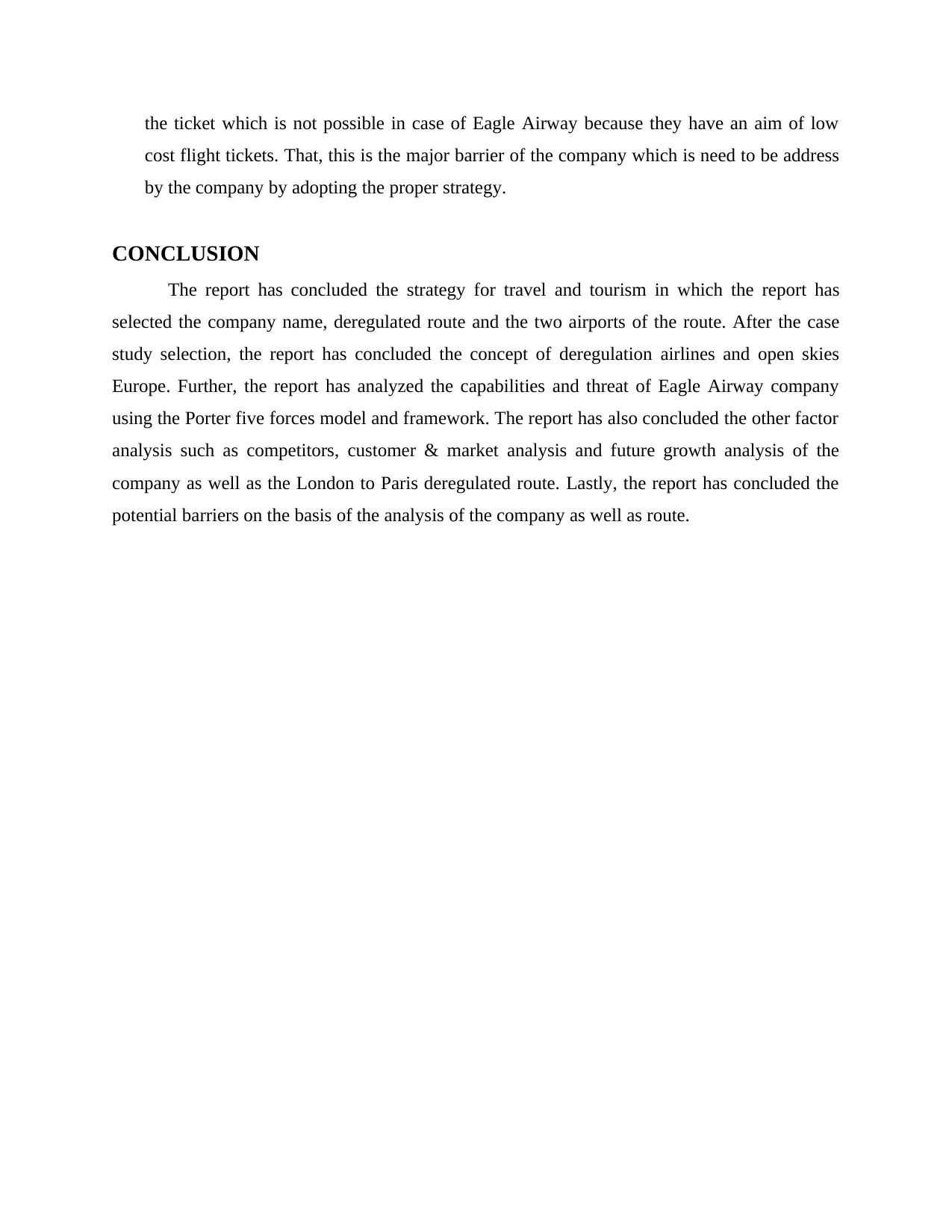
the ticket which is not possible in case of Eagle Airway because they have an aim of low
cost flight tickets. That, this is the major barrier of the company which is need to be address
by the company by adopting the proper strategy.
CONCLUSION
The report has concluded the strategy for travel and tourism in which the report has
selected the company name, deregulated route and the two airports of the route. After the case
study selection, the report has concluded the concept of deregulation airlines and open skies
Europe. Further, the report has analyzed the capabilities and threat of Eagle Airway company
using the Porter five forces model and framework. The report has also concluded the other factor
analysis such as competitors, customer & market analysis and future growth analysis of the
company as well as the London to Paris deregulated route. Lastly, the report has concluded the
potential barriers on the basis of the analysis of the company as well as route.
cost flight tickets. That, this is the major barrier of the company which is need to be address
by the company by adopting the proper strategy.
CONCLUSION
The report has concluded the strategy for travel and tourism in which the report has
selected the company name, deregulated route and the two airports of the route. After the case
study selection, the report has concluded the concept of deregulation airlines and open skies
Europe. Further, the report has analyzed the capabilities and threat of Eagle Airway company
using the Porter five forces model and framework. The report has also concluded the other factor
analysis such as competitors, customer & market analysis and future growth analysis of the
company as well as the London to Paris deregulated route. Lastly, the report has concluded the
potential barriers on the basis of the analysis of the company as well as route.
Paraphrase This Document
Need a fresh take? Get an instant paraphrase of this document with our AI Paraphraser
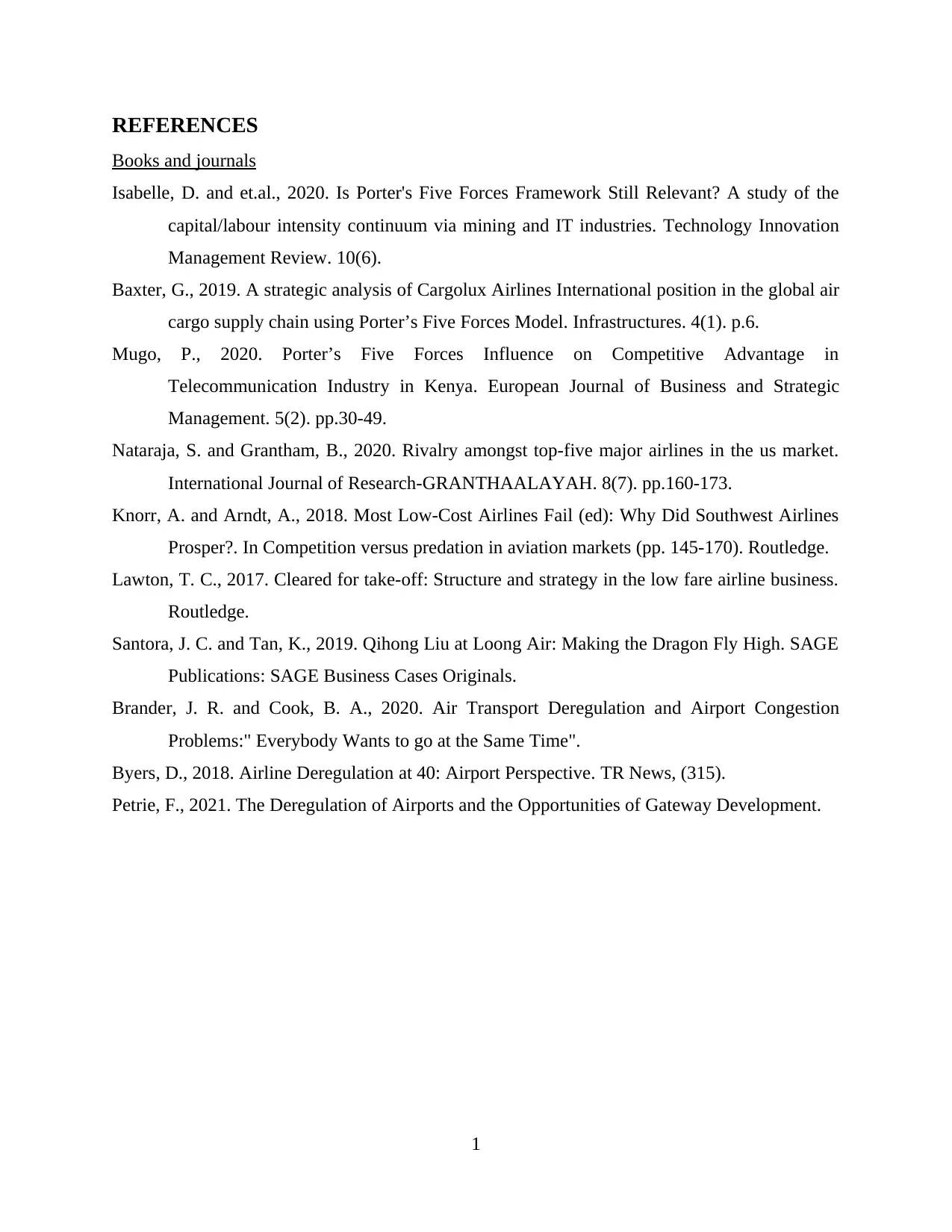
REFERENCES
Books and journals
Isabelle, D. and et.al., 2020. Is Porter's Five Forces Framework Still Relevant? A study of the
capital/labour intensity continuum via mining and IT industries. Technology Innovation
Management Review. 10(6).
Baxter, G., 2019. A strategic analysis of Cargolux Airlines International position in the global air
cargo supply chain using Porter’s Five Forces Model. Infrastructures. 4(1). p.6.
Mugo, P., 2020. Porter’s Five Forces Influence on Competitive Advantage in
Telecommunication Industry in Kenya. European Journal of Business and Strategic
Management. 5(2). pp.30-49.
Nataraja, S. and Grantham, B., 2020. Rivalry amongst top-five major airlines in the us market.
International Journal of Research-GRANTHAALAYAH. 8(7). pp.160-173.
Knorr, A. and Arndt, A., 2018. Most Low-Cost Airlines Fail (ed): Why Did Southwest Airlines
Prosper?. In Competition versus predation in aviation markets (pp. 145-170). Routledge.
Lawton, T. C., 2017. Cleared for take-off: Structure and strategy in the low fare airline business.
Routledge.
Santora, J. C. and Tan, K., 2019. Qihong Liu at Loong Air: Making the Dragon Fly High. SAGE
Publications: SAGE Business Cases Originals.
Brander, J. R. and Cook, B. A., 2020. Air Transport Deregulation and Airport Congestion
Problems:" Everybody Wants to go at the Same Time".
Byers, D., 2018. Airline Deregulation at 40: Airport Perspective. TR News, (315).
Petrie, F., 2021. The Deregulation of Airports and the Opportunities of Gateway Development.
1
Books and journals
Isabelle, D. and et.al., 2020. Is Porter's Five Forces Framework Still Relevant? A study of the
capital/labour intensity continuum via mining and IT industries. Technology Innovation
Management Review. 10(6).
Baxter, G., 2019. A strategic analysis of Cargolux Airlines International position in the global air
cargo supply chain using Porter’s Five Forces Model. Infrastructures. 4(1). p.6.
Mugo, P., 2020. Porter’s Five Forces Influence on Competitive Advantage in
Telecommunication Industry in Kenya. European Journal of Business and Strategic
Management. 5(2). pp.30-49.
Nataraja, S. and Grantham, B., 2020. Rivalry amongst top-five major airlines in the us market.
International Journal of Research-GRANTHAALAYAH. 8(7). pp.160-173.
Knorr, A. and Arndt, A., 2018. Most Low-Cost Airlines Fail (ed): Why Did Southwest Airlines
Prosper?. In Competition versus predation in aviation markets (pp. 145-170). Routledge.
Lawton, T. C., 2017. Cleared for take-off: Structure and strategy in the low fare airline business.
Routledge.
Santora, J. C. and Tan, K., 2019. Qihong Liu at Loong Air: Making the Dragon Fly High. SAGE
Publications: SAGE Business Cases Originals.
Brander, J. R. and Cook, B. A., 2020. Air Transport Deregulation and Airport Congestion
Problems:" Everybody Wants to go at the Same Time".
Byers, D., 2018. Airline Deregulation at 40: Airport Perspective. TR News, (315).
Petrie, F., 2021. The Deregulation of Airports and the Opportunities of Gateway Development.
1
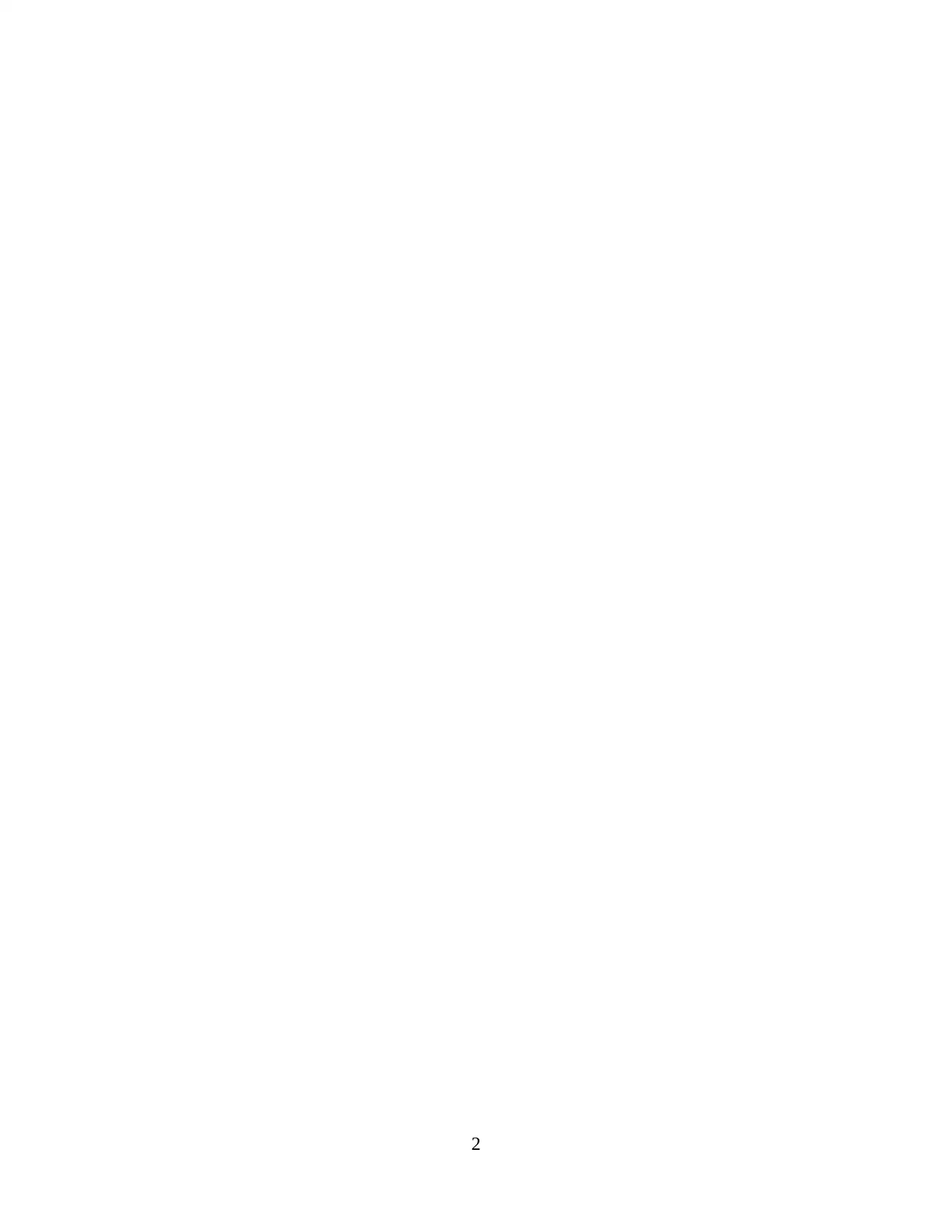
2
⊘ This is a preview!⊘
Do you want full access?
Subscribe today to unlock all pages.

Trusted by 1+ million students worldwide
1 out of 12
Related Documents
Your All-in-One AI-Powered Toolkit for Academic Success.
+13062052269
info@desklib.com
Available 24*7 on WhatsApp / Email
![[object Object]](/_next/static/media/star-bottom.7253800d.svg)
Unlock your academic potential
Copyright © 2020–2025 A2Z Services. All Rights Reserved. Developed and managed by ZUCOL.





